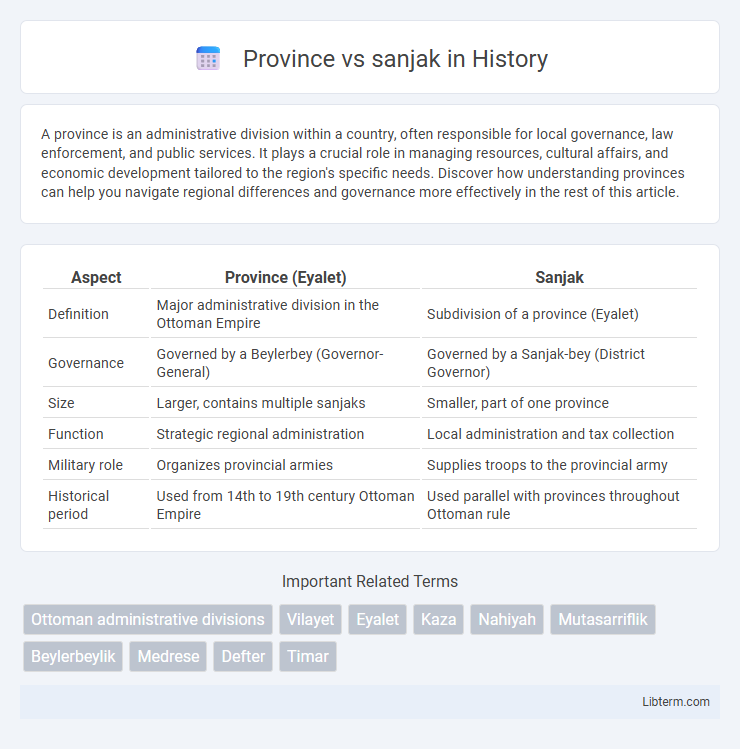A province is an administrative division within a country, often responsible for local governance, law enforcement, and public services. It plays a crucial role in managing resources, cultural affairs, and economic development tailored to the region's specific needs. Discover how understanding provinces can help you navigate regional differences and governance more effectively in the rest of this article.
Table of Comparison
| Aspect | Province (Eyalet) | Sanjak |
|---|---|---|
| Definition | Major administrative division in the Ottoman Empire | Subdivision of a province (Eyalet) |
| Governance | Governed by a Beylerbey (Governor-General) | Governed by a Sanjak-bey (District Governor) |
| Size | Larger, contains multiple sanjaks | Smaller, part of one province |
| Function | Strategic regional administration | Local administration and tax collection |
| Military role | Organizes provincial armies | Supplies troops to the provincial army |
| Historical period | Used from 14th to 19th century Ottoman Empire | Used parallel with provinces throughout Ottoman rule |
Introduction: Defining Province and Sanjak
A province is a large territorial unit serving as the primary administrative division within an empire or country, often governed by a governor or similar official. In contrast, a sanjak is a smaller administrative district within a province, typically overseen by a sanjak-bey, functioning as a subdivision to manage local governance and tax collection. Provinces encompass multiple sanjaks, establishing a hierarchical administrative structure vital for efficient control and organization.
Historical Origins of Provinces and Sanjaks
Provinces and sanjaks originated as key administrative divisions in the Ottoman Empire, with provinces (eyalets) established during the 14th century to consolidate territorial control and facilitate governance. Sanjaks emerged as smaller districts within provinces, created to enhance local administration and military organization, each governed by a sanjakbey. The hierarchical structure reflected the empire's need for efficient tax collection, law enforcement, and regional management during its expansion.
Administrative Structure: Province vs Sanjak
A province functioned as a primary administrative division in the Ottoman Empire, governed by a beylerbey or vali, overseeing multiple sanjaks within its territory. Each sanjak, a secondary administrative unit, was managed by a sanjakbey responsible for local governance, tax collection, and military recruitment. The hierarchical structure allowed provinces to coordinate broader regional administration, while sanjaks focused on localized management and law enforcement.
Geographic Scope and Jurisdiction
A province, or eyalet, in the Ottoman Empire covered a large geographic area and functioned as a primary administrative division with significant autonomous authority under a beylerbey. A sanjak was a smaller district within a province, governed by a sanjakbey, responsible for local administration, tax collection, and military recruitment. The geographic scope of a sanjak was limited compared to a province, serving as a subdivision to facilitate more efficient governance and control over specific regions.
Governance and Leadership Roles
A province, known as an eyalet or vilayet in the Ottoman context, functioned as a larger administrative unit governed by a Beylerbey or a Vali appointed by the Sultan, responsible for military, fiscal, and judicial authority. A sanjak, as a subdivision of a province, was led by a Sanjakbey who managed local governance, tax collection, and maintained order while reporting to the provincial governor. Provinces held broader strategic importance and autonomy, whereas sanjaks operated as localized administrative districts ensuring direct Ottoman control.
Evolution through Ottoman and Post-Ottoman Periods
Provinces (vilayets) and sanjaks represented hierarchical administrative units in the Ottoman Empire, with provinces encompassing several sanjaks, each governed by appointed officials. Over time, especially during the Tanzimat reforms in the 19th century, provinces were restructured to enhance centralized control, improving administrative efficiency and taxation systems. In the Post-Ottoman period, the dissolution of the empire led to the transformation or abolition of these units, with successor states adopting new administrative divisions reflecting nationalist and modern state-building efforts.
Functions and Responsibilities
A province, or eyalet, served as a major administrative division in the Ottoman Empire responsible for governance, tax collection, military recruitment, and maintaining law and order across a vast territory. A sanjak functioned as a subunit within a province, focusing on more localized administration, including managing local resources, overseeing smaller military forces, and implementing provincial directives. Provinces coordinated broad fiscal policies and defense strategies, while sanjaks ensured effective governance at the district level through direct interaction with local populations and officials.
Impact on Local Populations
Provinces, as larger Ottoman administrative units, imposed broader governance structures that often centralized tax collection and military conscription, affecting diverse local populations with standardized policies. Sanjaks, being smaller subdivisions within provinces, allowed for more localized administration and somewhat greater adaptation to ethnic, religious, and cultural specificities, moderating direct impacts on daily life. The differential administrative reach of provinces and sanjaks shaped local economic activities, social organization, and community relations, influencing regional stability and identity formation.
Modern Usage and Legacy
Provinces today function as primary administrative divisions in many countries, reflecting a legacy of historical sanjaks, which were Ottoman-era districts subordinate to provinces (eyalets or vilayets). Modern provinces often retain the territorial boundaries and governance structures influenced by sanjak organization, emphasizing localized administration and regional identity. This legacy persists in administrative terminology and regional governance models across former Ottoman territories, contributing to contemporary political and cultural frameworks.
Key Differences Summarized
Provinces were large administrative regions in the Ottoman Empire, governed by a beylerbey with broad military and civil authority, while sanjaks were smaller subdivisions within provinces, managed by sanjakbeys who reported to the provincial governor. Provinces held greater strategic importance and autonomy, overseeing multiple sanjaks, land revenues, and tax collection, whereas sanjaks focused primarily on local governance and administrative duties. The hierarchical structure established provinces as primary governance units, enabling centralized control over diverse territories, with sanjaks serving as essential intermediaries for efficient regional management.
Province Infographic

 libterm.com
libterm.com